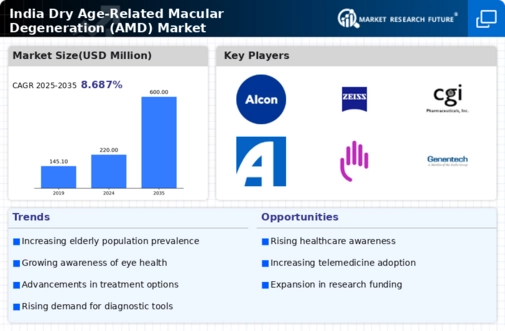Aging Population in India
The demographic shift towards an older population in India is a crucial driver for the dry age-related-macular-degeneration-amd market. As life expectancy increases, the prevalence of age-related diseases, including AMD, is likely to rise. Reports indicate that by 2030, the population aged 60 and above in India is expected to reach approximately 300 million, which could lead to a significant increase in AMD cases. This growing segment of the population may require enhanced healthcare services and treatment options, thereby driving demand in the dry age-related-macular-degeneration-amd market. Furthermore, the aging population may lead to increased healthcare expenditure, with estimates suggesting that healthcare costs for elderly individuals could rise by 20% annually, further propelling the market's growth.
Rising Healthcare Expenditure
India's increasing healthcare expenditure is another significant driver for the dry age-related-macular-degeneration-amd market. The government and private sectors are investing more in healthcare infrastructure and services, which is likely to improve access to eye care and AMD treatments. In recent years, healthcare spending in India has grown to about 3.5% of GDP, with projections indicating a potential increase to 5% by 2025. This rise in expenditure may facilitate the development of advanced treatment options and technologies for AMD, thereby enhancing patient outcomes. Additionally, as more individuals seek treatment for AMD, the market could experience a surge in demand for innovative therapies and preventive measures, further stimulating growth in the dry age-related-macular-degeneration-amd market.
Advancements in Diagnostic Technologies
Technological innovations in diagnostic tools are transforming the landscape of the dry age-related-macular-degeneration-amd market. Enhanced imaging techniques, such as optical coherence tomography (OCT), are enabling earlier detection and more accurate monitoring of AMD. These advancements are crucial, as early intervention can significantly improve patient outcomes. The adoption of such technologies in India is expected to rise, driven by both public and private healthcare initiatives aimed at improving eye care services. As diagnostic capabilities expand, the market may witness a surge in demand for effective treatment options, as healthcare providers become more equipped to identify and manage AMD cases promptly.
Increased Incidence of Chronic Diseases
The correlation between chronic diseases and the prevalence of AMD is becoming increasingly evident in India. Conditions such as diabetes and hypertension, which are on the rise, have been linked to a higher risk of developing AMD. With diabetes prevalence projected to reach 134 million by 2045 in India, the potential for increased AMD cases is substantial. This trend suggests that as the population grapples with chronic health issues, the demand for AMD-related treatments will likely escalate. Consequently, the dry age-related-macular-degeneration-amd market may see a corresponding increase in the need for specialized care and management strategies tailored to patients with chronic diseases.
Growing Awareness and Education Initiatives
The increasing focus on public health education regarding eye health is a vital driver for the dry age-related-macular-degeneration-amd market. Various organizations and government bodies are launching awareness campaigns to educate the population about AMD and its risk factors. These initiatives aim to inform individuals about the importance of regular eye check-ups and early detection. As awareness grows, more people are likely to seek medical advice and treatment for AMD, potentially leading to a rise in market demand. Furthermore, educational programs targeting healthcare professionals may enhance the quality of care provided to AMD patients, thereby positively impacting the dry age-related-macular-degeneration-amd market.






















Leave a Comment